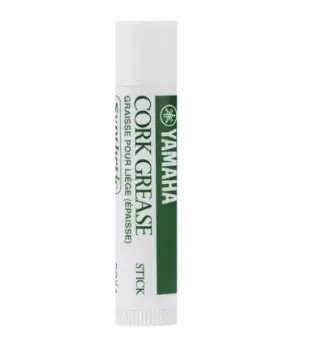You may have noticed a chapstick type tube that came with your saxophone.
What is it? What is it used for, and why does it matter?
It is one of the most important cleaning tools every saxophonist should have.
Do Saxophones Need Cork Grease?
Cork grease is a lubricant that is used to keep the cork in great shape and is used for woodwind instruments, including saxophones.
While you could get away without using it, you will be better off with it. Why?
Without cork grease, you will often have to use a lot of effort to get the mouthpiece on the neck. Eventually, this strain will tear up the cork, and it will need to be replaced.
It will as well lead to more permanent compressing of the cork, which will lead to air leaking out of the mouthpiece. Also, if you are twisting and putting in a lot of effort to get the mouthpiece on, that will put a lot of unnecessary strain on the neck.
This can lead to the neck being possibly bent.
What is Cork Grease Made Of?
Cork grease is made out of a combination of plant oils, such as elm extract, sunflower oil, coconut oil, and hemp seed oil.
It was previously made from animal products. Lanolin, which comes from sheep wool, was an example of one such ingredient.
How Do I Use Cork Grease?
Just put a little bit on the cork and rub it around with your finger. You can also put it on your finger first and then apply it to the cork.
Important Note
When putting on the mouthpiece, make sure the neck is not connected to the body. Put the mouthpiece on the neck, and then put the neck on the body. If you try to put the mouthpiece on the neck while it is attached to the body, this can cause strain on the neck which can lead to problems.
What is the Best Cork Grease for Saxophones?
There is no particular brand that is best, but Yamaha, Rico, Vandoren, D’Addario, and Selmer are some good ones to start with and are commonly used by woodwind players.

How Often Should You Use Cork Grease for Saxophones?
The important thing is that the cork stays relatively lubricated.
For me, I do it every day, before I play. I have found that this makes my cork last for years.
This is helpful not only because I don’t tear up the cork, but it also allows me a “set it and forget it” method when it comes to tuning because I know where the instrument is naturally in tune without having to adjust to new corks.
But, some people only do it once or twice a week if they are playing every day. It depends on you, but the most important part is that the cork stays lubricated.
Where Do You Apply Cork Grease?
Cork grease for the saxophone would be applied to the neck. It can also be applied to the receiving part of the neck.

Can You Put Cork Grease on the Neck of the Saxophone?
If you have trouble fitting the neck into the body, an easy fix is to put cork grease on the receiver end of the neck where it connects to the body.
In contrast to the cork, you only have to use it a little bit. This will keep it working well for a long time.
Saxophone Cork Grease Substitutes
Just go buy some cork grease! It’s easy to get and it works well.
Other alternatives to cork grease normally used:
- Other types of oils are messy and often ineffective, or they take a significant preparation time when you could just go buy cork grease.
- Sometimes people use Vaseline or petroleum jelly. I don’t recommend these because they can destroy the cork as it is oil-based, which defeats part of the purpose of cork grease in the first place.
- Lanolin is another popular substitute that works well and comes from sheep wool.
- Also, a very popular quick fix if you don’t have any cork grease is saliva. It works well to lubricate the mouthpiece/cork when you find yourself without cork grease.
Final Notes
Cork grease helps to improve the life of the cork, which also can help the health of the neck as well.
In addition, it can provide stability in your tuning if you don’t have to keep changing corks constantly.
While it is not a make-or-break method for your improvement on the saxophone, regular cork grease application is one way to keep the saxophone as stable as possible so you can focus on learning.
Can You Use Vaseline Instead of Cork Grease?
Vaseline or petroleum jelly are sometimes used instead of cork grease, but I don’t recommend these because they can destroy the cork as it is oil-based. It can defeat part of the purpose of cork grease in the first place.

Author: Cooper White
- Cooper is a Multi-Instrumentalist, with vast knowledge and experience performing with Sax, Flute, Clarinet, Keyboard, and Blues Harmonica.
- With a Bachelor’s Degree from the Berklee College of Music in Boston and studies in Classical Performance at the Lionel Hampton School of Music, he has also more than 10 years of performing professionally, whether while road touring in the U.S. or playing on different cruise ships.
- He is also an entertainer with his shows, as well as a producer of his music and others. Whenever he is not performing, he teaches individual online classes. He mostly plays Jazz, Classical and Popular music.
